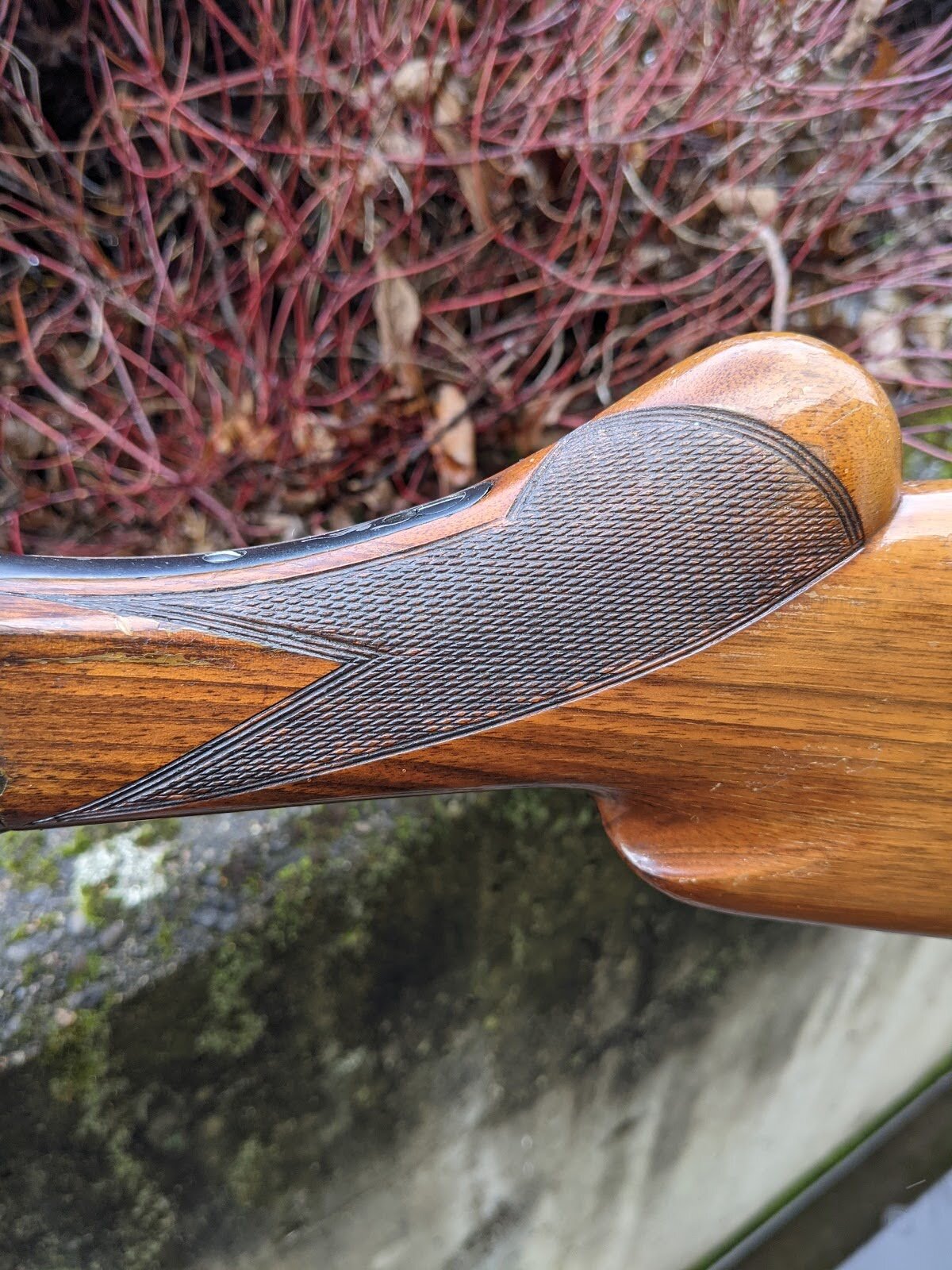How Repair Damaged Checking On Gun Stock
Feat of the Week: Checkering Restoration
The Gunsmithing Story

Restored Checkering on Customer's Browning A5 Stock
This week'due south gunsmithing feat is about a checkering repair task on a Browning A5. I'1000 excited to tell yous more about my procedure and how I learned this skill. Then let'southward go started!
This customer brought his gun to u.s. because someone had attempted to fix a few cracks on his Browning A5 and had damaged the stock in the process.
They didn't clean up the cracks before gluing them, used the wrong mucilage, and left gum all over the gun. And, not simply did the cracks go repaired improperly, but the terminate and checkering were also ruined.
To start fixing these problems, I removed the glue from the wood and began to clean up the cracks. While they expect much amend now, the cracks didn't shut also as they would've if I had been the one to set them in the first place. After fixing the cracks, I prepare out to repair the checkering.
What is Checkering?
Checkering, for those that don't know, is an aesthetic feature on many long guns. Lines are carved into the forest to grade parallel channels. These grooves intersect to create diverse patterns—often diamonds. While by and large decorative, checkering also improves grip for the shooter—especially in moisture atmospheric condition. The water seeps into the grooves and out of the way of the shooter's hand.

Example of Checkering Pattern from Gunsmithing School
Traditionally, guns are mitt checkered. Walnut is probably one of the all-time forest for checkering, and Stocks made from American Walnut are really common—especially on guns from the 50s and 60s. The file cuts hands and cleanly on Walnut. On forest that are too soft, the files rip rather than cut, and on harder woods, etching the lines tin can be difficult.
The Checkering Process
While repair is the mechanical side of gunsmithing, checkering is the artisan side. It is a dull process which requires a lot of attention to item and focus.

Restored Checkering on Customer's Browning A5 Forearm
In this instance, I was hired to restore the checkering considering the grooves had go also shallow. While this might seem like an easy job, it is really more difficult than checkering from scratch—just like it is harder to replicate someone'southward handwriting than to merely write in your own. Every gunsmith has their ain style, and it'southward challenging to replicate their class of checkering.
With multiple gunsmiths checkering a single gun, in that location'due south a danger of inconsistency in the lines. And so, to ensure that I kept the gaps compatible, I used a double line tool. 1 part of the tool follows the previous line and the cutting end of the tool carves the new channel. Each line required multiple passes to get the grooves to the proper depth. At the end of this ii hour process, I refinished the stock.
My chore is to restore the checkering to its original grade. If washed properly, no 1 volition e'er know that I touched this gun (except that I wrote a blog mail service almost it). It's not my chore to add a personal flare to information technology but to repair the work washed by the original craftsman.
Learning the Skill
While at Trinidad State'southward Gunsmithing Schoolhouse, I learned checkering from one of the best stock makers in the country Glen Morovits. He also taught me how to make and repair stocks—you tin read more about that in my previous web log postal service here.

Practice Lines from my Checkering 101 Class
I took 2 checkering classes with Glen. Because checkering is more of an art grade than a mechanical skill, this class was considered an constituent and was not required for graduation. In my kickoff semester, I took Checkering 101 where I learned the bones skills and fundamentals. At that place was a lot of trying and declining—slipping out of the aqueduct and many crooked lines. Much of what I learned was how to fix these mistakes. We used practise pieces of woods only. While the last was checkering on 1911 grips, I didn't go to touch on a gun stock one time in that class.
In my next checkering course, though, we began working on bodily stocks. We learned how to make dissimilar patterns like flattop checkering and skip line—which is my favorite. For that final, we completed a checkering project on a gun stock.
Even though checkering isn't one of our most mutual services at McCluskey Artillery, I beloved getting the opportunity to explore the artistic side of gunsmithing. Whether it's creating my ain checkering lines and patterns or only restoring someone else'south work, the process, for me, is relaxing and rewarding.
Next Up
Nosotros promise y'all enjoyed this week's gunsmithing feat. Give thanks you for following along! Our next feature will be posted Monday, December 21st at 9am. Annotate for any content you want to see.
If you loved the services yous saw today, check out our online store! You tin can start shopping by clicking hither. Or drop us a message here. And don't forget to follow united states of america on social media! We look forward to meeting you and gunsmithing for you
How Repair Damaged Checking On Gun Stock,
Source: https://www.themccluskeyarmscompany.com/feat-of-the-week-gunsmithing-blog/feat-of-the-week-checkering-restoration
Posted by: craigdumbet.blogspot.com


0 Response to "How Repair Damaged Checking On Gun Stock"
Post a Comment